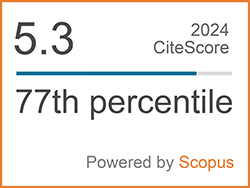In vitro and In silico Antibacterial Potency of Eucalyptus Leaf Oil from Hybrid Clones of E. grandis with E. urophylla and E. pellita
Abstract
Keywords
[1] T. C. Wilson, S. Rutherford, J.-Y. S. Yap, S. M. Douglas, E. Lee, and M. Rossetto, “Eucalyptus cryptica (Myrtaceae): A critically endangered new species,” Australian Systematic Botany, vol. 36, no. 5, pp. 386–400, 2023, doi: 10.1071/ SB22031.
[2] A. K. Dhakad, V. V. Pandey, S. Beg, J. M. Rawat, and A. Singh, “Biological, medicinal and toxicological significance of Eucalyptus leaf essential oil: A review,” Journal of the Science of Food and Agriculture, vol. 98, no. 3, pp. 833–848, 2018, doi: 10.1002/jsfa.8600.
[3] I. Nezu, F. Ishiguri, H. Aiso, S. Diloksumpun, J. Ohshima, K. Iizuka, and S. Yokota, “Selection of Eucalyptus camaldulensis families for sustainable pulpwood production by means of anatomical characteristics,” Forests, vol. 12, no. 1, pp. 1–11, 2021. doi: 10.3390/f12010031.
[4] F. J. N. França, T. S. F. A. França, and G. B. Vidaurre, “Effect of growth stress and interlocked grain on splitting of seven different hybrid clones of Eucalyptus grandis × Eucalyptus urophylla wood,” Holzforschung, vol. 74, no. 10, pp. 917–926, 2020. doi: 10.1515/ hf-2019-0209.
[5] K. M. Charles and I. Stehlik, “Assisted species migration and hybridization to conserve cold-adapted plants under climate change,” Conservation Biology, vol. 35, no. 2, pp. 559–566, 2021. doi: 10.1111/cobi.13583.
[6] M. Gonzalez Guzman, F. Cellini, V. Fotopoulos, R. Balestrini, and V. Arbona, “New approaches to improve crop tolerance to biotic and abiotic stresses,” Physiologia Plantarum, vol. 174, no. 1, 2022, Art. no. e13547, doi: 10.1111/ppl.13547.
[7] A. Kashyap, P. Garg, K. Tanwar, J. Sharma, N. C. Gupta, P. T. T. Ha, and M. Rao, “Strategies for utilization of crop wild relatives in plant breeding programs,” Theoretical and Applied Genetics, vol. 135, no. 12, pp. 4151–4167, 2022, doi: 10.1007/s00122-022-04220-x.
[8] M. Yousuf and D. Alim, “Selection and hybridization techniques for stress management and quality improvement in rice,” Rice Research for Quality Improvement: Genomics and Genetic Engineering, vol. 1, pp. 201–220, 2020, doi: 10.1007/978-981-15-4120-9_8.
[9] J. Zhou, Y. Yang, Y. Lv, Q. Pu, J. Li, Y. Zhang, and D. Tao, “Interspecific hybridization is an important driving force for origin and diversification of asian cultivated rice Oryza sativa L.,” Frontiers in Plant Science, vol. 13, 2022, Art. no. 932737, doi: 10.3389/fpls.2022. 932737.
[10] Y. Wang and S. Dong, “A new roadmap for the breeding of disease-resistant and high-yield crops,” Stress Biology, vol. 1, no. 1, pp. 4–6, 2021, doi: 10.1007/s44154-021-00023-0.
[11] A. Myburg, D. Grattapaglia, G. Tuskan, J. Jenkins, J. Schmutz, E. Mizrachi, and D. Rokhsar, “The Eucalyptus grandis genome Project: genome and transcriptome resources for comparative analysis of woody plant biology,” BMC Proceedings, vol. 5, no. S7, pp. 1–2, 2011, doi: 10.1186/1753-6561-5-s7-i20.
[12] D. Rengel, H. S. Clemente, F. Servant, N. Ladouce, E. Paux, P. Wincker, and J. Grima-Pettenati, “A new genomic resource dedicated to wood formation in Eucalyptus,” BMC Plant Biology, vol. 9, p. 36, 2009, doi: 10.1186/1471-2229-9-36.
[13] A. C. Toloza, A. Lucia, E. Zerba, H. Masuh, and M. I. Picollo, “Interspecific hybridization of Eucalyptus as a potential tool to improve the bioactivity of essential oils against permethrin-resistant head lice from Argentina,” Bioresource Technology, vol. 99, no. 15, pp. 7341–7347, 2008, doi: 10.1016/j.biortech.2007.12.067.
[14] Z. Liu, J. Wang, M. Yin, M. Liu, and W. Gao, “Gas chromatography-mass spectrometry analysis of variations in the essential leaf oil of 6 Eucalyptus species and allelopathy of mechanism 1, 8-cineole,” Ciência Rural, vol. 53, no. 3, 2022, Art. no. e20210687, doi: 10.1590/ 0103-8478cr20210687.
[15] R. Arisandi, S. N. Marsoem, G. Lukmandaru, T. Ashitani, and K. Takahashi, “The contents of phenolics and cell wall component of Eucalyptus pellita F. Muell stemwood and bark,” Wood Research, vol. 64, no. 3, pp. 411–422, 2019,
[16] W. Insuan and T. Chahomchuen, “Chemical composition and antimicrobial activity of essential oil extracted from Eucalyptus citriodora leaf,” Microbiology and Biotechnology Letters, vol. 48, no. 2, pp. 148–157, 2020, doi: 10.4014/ mbl.1912.12016.
[17] L. Zhou, J. Li, Q. Kong, S. Luo, J. Wang, S. Feng, and C. Ding, “Chemical composition, antioxidant, antimicrobial, and phytotoxic potential of Eucalyptus grandis × E. urophylla leaves essential oils,” Molecules, vol. 26, no. 5, 2021, doi: 10.3390/molecules26051450.
[18] M. Asif, M. Saleem, M. Saadullah, H. S. Yaseen, and R. Al Zarzour, “COVID-19 and therapy with essential oils having antiviral, anti-inflammatory, and immunomodulatory properties,” Inflammopharmacology, vol. 28, pp. 1153–1161, 2020, doi: 10.1007/s10787-020-00744-0.
[19] J. Li, W. Chen, H. Liu, H. Liu, S. Xiang, F. You, Y. Jiang, J. Lin, D. Zhang, and C. Zheng, “Pharmacologic effects approach of essential oils and their components on respiratory diseases,” Journal of Ethnopharmacology, vol. 304, 2023, Art. no. 115962, doi: 10.1016/j.jep. 2022.115962.
[20] D. M. Galan, N. E. Ezeudu, J. Garcia, C. A. Geronimo, N. M. Berry, and B. J. Malcolm, “Eucalyptol (1,8-cineole): an underutilized ally in respiratory disorders,” Journal of Essential Oil Research, vol. 32, no. 2, pp. 103–110, 2020, doi: 10.1080/10412905.2020.1716867.
[21] D. Mieres-Castro, S. Ahmar, R. Shabbir, and F. Mora-Poblete, “Antiviral activities of Eucalyptus essential oils: Their effectiveness as therapeutic targets against human viruses,” Pharmaceuticals, vol. 14, no. 12, p. 1210, 2021, doi: 10.3390/ ph14121210.
[22] L. J. Juergens, H. Worth, and U. R. Juergens, “New perspectives for mucolytic, anti-inflammatory and adjunctive therapy with 1,8-cineole in COPD and asthma: Review on the new therapeutic approach,” Advances in Therapy, vol. 37, no. 5, pp. 1737–1753, 2020, doi: 10.1007/s12325-020-01279-0.
[23] N. Dharani and A. Yenesew, An Illustrated Guide to Medicinal Plants of East Africa. Cape Town, ZA: Penguin Random House South Africa, 2022.
[24] O. S. Soyingbe, A. Oyedeji, A. K. Basson, and A. R. Opoku, “The essential oil of Eucalyptus grandis W. Hill ex Maiden inhibits microbial growth by inducing membrane damage,” Chinese Medicine, vol. 4, no. 1, 2013, Art. no. 41002, doi: 10.4236/cm.2013.41002
[25] S. Mulyaningsih, F. Sporer, J. Reichling, and M. Wink, “Antibacterial activity of essential oils from Eucalyptus and of selected components against multidrug-resistant bacterial pathogens,” Pharmaceutical Biology, vol. 49, no. 9, pp. 893–899, 2011, doi: 10.3109/13880209.2011.553625.
[26] S. Silaban, B. Nainggolan, M. Simorangkir, T. S. Zega, P. M. Pakpahan, and K. Gurning, “Antibacterial activities test and brine shrimp lethality test of Simargaolgaol (Aglaonema modestum Schott ex Engl.) leaves from North Sumatera, Indonesia,” Rasayan Journal of Chemistry, vol. 15, no. 2, pp. 745–750, 2022, doi: 10.31788/RJC.2022.1526911.
[27] J. Eberhardt, D. Santos-Martins, A. F. Tillack, and S. Forli, “AutoDock Vina 1.2.0: new docking methods, expanded force field, and python bindings,” Journal of Chemical Information and Modeling, vol. 61, no. 8, pp. 3891–3898, 2021, doi: 10.1021/acs.jcim.1c00203.
[28] O. Trott and A. J. Olson, “AutoDock Vina: Improving the speed and accuracy of docking with a new scoring function, efficient optimization, and multithreading,” Journal of Computational Chemistry, vol. 31, no. 2, pp. 455–461, 2010, doi: 10.1002/jcc.21334.
[29] D. J. Haydon, N. R. Stokes, R. Ure, G. Galbraith, J. M. Bennett, D. R. Brown, P. J. Baker, V. V. Barynin, D. W. Rice, S. E. Sedelnikova, J. R. Heal, “An inhibitor of FtsZ with potent and selective anti-staphylococcal activity,” Science, vol. 321, no. 5896, pp. 1673–1675, 2008, doi: 10.1126/science.1159961.
[30] J. Lu, S. Patel, N. Sharma, S. M. Soisson, R. Kishii, M. Takei, Y. Fukuda, K. J. Lumb, and S. B. Singh, “Structures of kibdelomycin bound to Staphylococcus aureus GyrB and ParE showed a novel U-shaped binding mode,” ACS Chemical Biology, vol. 9, no. 9, pp. 2023–2031, 2014, doi: 10.1021/cb5001197.
[31] S. Fieulaine, M. Desmadril, T. Meinnel, and C. Giglione, “Understanding the highly efficient catalysis of prokaryotic peptide deformylases by shedding light on the determinants specifying the low activity of the human counterpart,” Acta Crystallographica Section D: Biological Crystallography, vol. 70, no. 2, pp. 242–252, 2014, doi: 10.1107/S1399004713026461.
[32] A. Nadhilah and R. P. Ilhamisari, “Effects of leaf storage and distillation time on the quality of Eucalyptus (Eucalyptus grandis) essential oil,” 3BIO: Journal of Biological Science, Technology and Management, vol. 4, no. 1, pp. 1–7, 2022, doi: 10.5614/3bio.2022.4.1.1.
[33] C. O’Connor, “Meiosis, genetic recombination, and sexual reproduction,” Nature Education, vol. 1, no. 1, p. 174, 2008.
[34] Z. Ma, Q. Xie, G. Li, H. Jia, J. Zhou, Z. Kong, W. Li, and Y. Yuan, “Germplasms, genetics and genomics for better control of disastrous wheat Fusarium head blight,” Theoretical and Applied Genetics, vol. 133, no. 5, pp. 1541–1568, 2020, doi: 10.1007/s00122-019-03525-8.
[35] A. A. Khan, B. Iqbal, A. Jalal, K. A. Khan, A. Al-Andal, I. Khan, M. Elboughdiri, and N. Elboughdiri, “Advanced molecular approaches for improving crop yield and quality: A review,” Journal of Plant Growth Regulation, vol. 43, no. 7, pp. 2091–2103, 2024, doi: 10.1007/s00344-024-11253-7.
[36] E. B. Hardiyanto, M. A. Inail, D. S. Mendham, E. Thaher, and B. K. Sitorus, “Eucalyptus pellita coppice vs. seedlings as a re-establishment method in South Sumatra, Indonesia,” Forests, vol. 13, no. 7, p. 1017, 2022, doi: 10.3390/ f13071017.
[37] Surbhi, A. Kumar, S. Singh, P. Kumari, and P. Rasane, “Eucalyptus: phytochemical composition, extraction methods and food and medicinal applications,” Advances in Traditional Medicine, vol. 23, no. 2, pp. 369–380, 2023, doi: 10.1007/s13596-021-00582-7.
[38] S. Das and B. Prakash, “Effect of environmental factors on essential oil biosynthesis, chemical stability, and yields,” in Plant Essential Oils: From Traditional to Modern-Day Application. Singapore: Springer Nature, pp. 225–247, 2023.
[39] T. Tsusaka, B. Makino, R. Ohsawa, and H. Ezura, “Genetic and environmental factors influencing the contents of essential oil compounds in Atractylodes lancea,” PLOS ONE, vol. 14, no. 5, p. 1–14, 2019, doi: 10.1371/journal. pone.0217522.
[40] S. Diloksumpun, N. Wongkattiya, K. Buaban, T. Saleepochn, P. Suttiarporn, and S. Luangkamin, “Variation in the antibacterial and antioxidant activities of essential oils of five new Eucalyptus urophylla S.T. Blake clones in Thailand,” Molecules, vol. 27, no. 3, p. 680, 2022, doi: 10.3390/molecules27030680.
[41] L. C. A. Barbosa, C. A. Filomeno, and R. R. Teixeira, “Chemical variability and biological activities of Eucalyptus spp. essential oils,” Molecules, vol. 21, no. 12, p. 1671, 2016, doi: 10.3390/molecules21121671.
[42] D. R. Batish, H. P. Singh, R. K. Kohli, and S. Kaur, “Eucalyptus essential oil as a natural pesticide,” Forest Ecology and Management, vol. 256, no. 12, pp. 2166–2174, 2008, doi: 10.1016/j.foreco.2008.08.008.
[43] B. Akacha, M. Michalak, I. Generalić Mekinić, M. Kačániová, M. Chaari, F. Brini, R. Ben Saad, W. Mnif, S. Garzoli, and A. Ben Hsouna, “Mixture design of α‐pinene, α‐terpineol, and 1,8‐cineole: A multiobjective response followed by chemometric approaches to optimize the antibacterial effect against various bacteria and antioxidant activity,” Food Science & Nutrition, vol. 12, no. 1, pp. 574–589, 2024, doi: 10.1002/fsn3.3780.
[44] H. Zengin and A. H. Baysal, “Antibacterial and antioxidant activity of essential oil terpenes against pathogenic and spoilage-forming bacteria and cell structure-activity relationships evaluated by SEM microscopy,” Molecules, vol. 19, no. 11, pp. 17773–17798, 2014, doi: 10.3390/molecules191117773.
[45] W. Mączka, A. Duda-Madej, A. Górny, M. Grabarczyk, and K. Wińska, “Can eucalyptol replace antibiotics?,” Molecules, vol. 26, no. 16, p. 1–16, 2021, doi: 10.3390/molecules26164933.
[46] A. Marchese, C. R. Arciola, R. Barbieri, A. S. Silva, S. F. Nabavi, A. J. T. Sokeng, and S. M. Nabavi, “Update on monoterpenes as antimicrobial agents: A particular focus on p-cymene,” Materials, vol. 10, no. 8, p. 1–15, 2017, doi: 10.3390/ma10080947.
[47] F. S. Shafodino, J. M. Lusilao, and L. M. Mwapagha, “Phytochemical characterization and antimicrobial activity of Nigella sativa seeds,” PLOS ONE, vol. 17, no. 8, p. 1–20, 2022, doi: 10.1371/journal.pone.0272457.
[48] T. A. S. Vieira, P. F. Trugilho, S. A. C. Carabineiro, A. J. V. Zanuncio, A. G. Carvalho, and M. Branco-Vieira, “Impact of chemical composition on Eucalyptus wood clones for sustainable energy production,” Forests, vol. 14, no. 11, p. 1–12, 2023, doi: 10.3390/f14112240.
[49] F. H. Fernandes, Z. D. R. Guterres, I. M. Violante, T. F. Lopes, W. S. Garcez, and F. R. Garcez, “Evaluation of mutagenic and antimicrobial properties of brown propolis essential oil from the Brazilian Cerrado biome,” Toxicology Reports, vol. 2, pp. 1482–1488, 2015, doi: 10.1016/j.toxrep.2015.11.007.
[50] T. M. Belete, “Novel targets to develop new antibacterial agents and novel alternatives to antibacterial agents,” Human Microbiome Journal, vol. 11, 2019, Art. no. 100052, doi: 10.1016/j.humic.2019.01.001.
[51] F. Collin, S. Karkare, and A. Maxwell, “Exploiting bacterial DNA gyrase as a drug target: Current state and perspectives,” Applied Microbiology and Biotechnology, vol. 92, pp. 479–497, 2011, doi: 10.1007/s00253-011-3557-z.
DOI: 10.14416/j.asep.2025.01.002
Refbacks
- There are currently no refbacks.
 Applied Science and Engineering Progress
Applied Science and Engineering Progress







